Information Fusion for Cultural Heritage Three-Dimensional Modeling of Malay Cities
Abstract
1. Introduction
2. Materials and Methods
2.1. Study Area
2.2. Methods
2.2.1. Pre-Processing
2.2.2. D Modeling Reconstruction
3. Results and Discussion
3.1. Result of Pre-Processing
3.2. Integration of MLS and UAV Data
3.3. Malay City Heritage 3D Modeling Reconstruction
4. Conclusions
Author Contributions
Funding
Acknowledgments
Conflicts of Interest
References
- Atheicardi, I.; Chiabrando, F.; Maria Lingua, A.; Noardo, F. Recent trends in cultural heritage 3D survey: The photogrammetric computer vision approach. J. Cult. Herit. 2018, 32, 257–266. [Google Scholar] [CrossRef]
- Barrile, V.; Nunnari, A.; Ponterio, R.C. Laser Scanner for the Architectural and Cultural Heritage and Applications for the Dissemination of the 3D Model. Procedia-Soc. Behav. Sci. 2016, 223, 555–560. [Google Scholar]
- Campanaro, D.M.; Landeschi, G.; Dell’Unto, N.; Touati, A.M.L. 3D GIS for cultural heritage restoration: A ‘white box’ workflow. J. Cult. Herit. 2016, 18, 321–332. [Google Scholar] [CrossRef]
- Verhoeven, G.J.J. Providing an archaeological bird’s-eye view-An overall pictureof ground-based meansto execute low-altitude aerial photography (LAAP) in archaeology. Archaeol. Prospect. 2019, 16, 233–249. [Google Scholar]
- Andrés, A.N.; Pozuelo, F.B.; Marimón, J.R.; Gisbert, A.d. Generation of virtual models of cultural heritage. J. Cult. Herit. 2012, 13, 103–106. [Google Scholar] [CrossRef]
- Gruen, A.; Huang, X.; Qin, R.; Du, T.; Fang, W.; Boavida, J.; Oliveira, A. Joint processing of UAV imagery and terrestrial mobile mapping system data for very high resolution city modeling. Int. Arch. Photogramm. Remote Sens. Spat. Inf. Sci. 2013, 175–182. [Google Scholar] [CrossRef]
- Guarnieri, A.; Remondino, F.; Vettore, A. Digital photogrammetry and TLS data fusion applied to Cultural Heritage 3D modeling. Int. Arch. Photogramm. Remote Sens. Spat. Inf. Sci. 2006, 36, 1–6. [Google Scholar]
- Rodríguez-Gonzálvez, P.; Muñoz-Nieto, A.L.; del Pozo, S.; Sanchez-Aparicio, L.J.; Gonzalez-Aguilera, D.; Micoli, L.; Barsanti, S.G.; Guidi, G.; Mills, J.; Fieber, K. 4D reconstruction and visualization of cultural heritage: Analyzing our legacy through time. Int. Arch. Photogramm. Remote Sens. Spat. Inf. Sci. 2017, 42, 609–616. [Google Scholar]
- Abdullah, A.A.A.; Noor, N.M.; Abdullah, A. Drone 3D mapping in identifying Malay urban form: Case study of Kota Bharu. In Proceedings of the IOP Conference Series: Earth and Environmental Science, 9th IGRSM International Conference and Exhibition on Geospatial & Remote Sensing (IGRSM 2018), Kuala Lumpur, Malaysia, 24–25 April 2018. [Google Scholar]
- Ramos, M.M.; Remondino, F. Data fusion in cultural heritage—A review. Int. Arch. Photogramm. Remote Sens. Spat. Inf. Sci. -Isprs Arch. 2015, 40, 359–363. [Google Scholar] [CrossRef]
- Van Genderen, J. Perspectives on the nature of geospatial information. Geo-Spat. Inf. Sci. 2017, 20, 57–58. [Google Scholar] [CrossRef]
- Hollick, J.; Helmholz, P.; Belton, D. Non-parametric belief propagation for mobile mapping sensor fusion. Geo-Spat. Inf. Sci. 2016, 19, 195–201. [Google Scholar]
- Dold, J.; Groopman, J. The future of geospatial intelligence. Geo-Spat. Inf. Sci. 2017, 20, 151–162. [Google Scholar] [CrossRef]
- Kamarudin, Z. Long-roofed Houses of Northeastern Peninsular Malaysia: Sustainability of Its Identity in the Built Environment. Procedia Environ. Sci. 2015, 28, 698–707. [Google Scholar] [CrossRef][Green Version]
- Hassan, Z.; Harun, S.N. Preservation of Malay Singgora Roof. Procedia Environ. Sci. 2013, 17, 729–738. [Google Scholar] [CrossRef]
- Ismail, Z.; Ahmad, A.S. Modularity Concept in Traditional Malay House (TMH) in Malaysia. Int. Conf. Constr. Ind. 2006, 1–12. [Google Scholar]
- Thompson, E.C. Rural villages as socially urban spaces in Malaysia. Urban Stud. 2004, 41, 2357–2376. [Google Scholar] [CrossRef]
- Murtiyoso, A.; Grussenmeyer, P. Documentation of heritage buildings using close-range UAV images: Dense matching issues, comparison and case studies. Photogramm. Rec. 2017, 32, 206–229. [Google Scholar] [CrossRef]
- Murtiyoso, A.; Koehl, M.; Grussenmeyer, P.; Freville, T. Acquisition and processing protocols for UAV images: 3D modeling of historical buildings using photogrammetry. ISPRS Ann. Photogramm. Remote Sens. Spat. Inf. Sci. 2017, 4, 163–170. [Google Scholar] [CrossRef]
- Guisado-Pintado, E.; Jackson, D.W.T.; Rogers, D. 3D mapping efficacy of a drone and terrestrial laser scanner over a temperate beach-dune zone. Geomorphology 2019, 328, 157–172. [Google Scholar] [CrossRef]
- Wang, Y.; Chen, Q.; Zhu, Q.; Liu, L.; Li, C.; Zheng, D. A survey of mobile laser scanning applications and key techniques over urban areas. Remote Sens. 2019, 11, 1540. [Google Scholar] [CrossRef]
- Bastonero, P.; Donadio, E.; Chiabrando, F.; Spanò, A. Fusion of 3D models derived from TLS and image-based techniques for CH enhanced documentation. ISPRS Ann. Photogramm. Remote Sens. Spat. Inf. Sci. 2014, 2, 73–80. [Google Scholar] [CrossRef]
- Rodríguez-Gonzálvez, P.; Campo, Á.G.; Muñoz-Nieto, Á.L. Sánchez-Aparicio, L.J.; González-Aguilera, D.; Diachronic reconstruction and visualization of lost cultural heritage sites. ISPRS Int. J. Geo-Inf. 2019, 8, 61. [Google Scholar]
- Balado, J.; Díaz-Vilariño, L.; Arias, P.; González-Jorge, H. Automatic classification of urban ground elements from mobile laser scanning data. Autom. Constr. 2018, 86, 226–239. [Google Scholar] [CrossRef]
- Gong, F.Y.; Zeng, Z.C.; Zhang, F.; Li, X.; Ng, E.; Norford, L.K. Mapping sky, tree, and building view factors of street canyons in a high-density urban environment. Build. Environ. 2018, 134, 155–167. [Google Scholar] [CrossRef]
- Haala, N.; Cefalu, A.; Kremer, J.; Peter, M. Mobile lidar mapping for urban data capture. In Proceedings of the 14th International Conference on Virtual Systems and Multimedia, Limassol, Cyprus, 20–25 October 2008. [Google Scholar]
- Früh, C.; Zakhor, A. Constructing 3D City Models by Merging Aerial and Ground Views. IEEE Comput. Graph. Appl. 2003, 23, 52–61. [Google Scholar] [CrossRef]
- Lambers, K.; Eisenbeiss, H.; Sauerbier, M.; Kupferschmidt, D.; Gaisecker, T.; Sotoodeh, S.; Hanusch, T. Combining photogrammetry and laser scanning for the recording and modelling of the Late Intermediate Period site of Pinchango Alto, Palpa, Peru. J. Archaeol. Sci. 2007, 34, 1702–1712. [Google Scholar] [CrossRef]
- Hassanalian, M.; Abdelkefi, A. Classifications, applications, and design challenges of drones: A review. Prog. Aerosp. Sci. 2017, 91, 99–131. [Google Scholar] [CrossRef]
- Oczipka, M.; Bemmann, J.; Piezonka, H.; Munkabayar, J.; Ahrens, B.; Achtelik, M.; Lehmann, F. Small drones for geo-archaeology in the steppe: Locating and documenting the archaeological heritage of the Orkhon Valley in Mongolia. In Proceedings of the Remote Sensing for Environmental Monitoring, GIS Applications, and Geology IX, Berlin, Germany, 31 August–3 September 2009. [Google Scholar]
- Chen, C.; Zou, X.; Tian, M.; Li, J.; Wu, W.; Song, Y.; Dai, W.; Yang, B. Low cost multi-sensor robot laser scanning system and its accuracy investigations for indoor mapping application. Int. Arch. Photogramm. Remote Sens. Spat. Inf. Sci. -Isprs Arch. 2017, 42, 83–85. [Google Scholar] [CrossRef]
- Ismail, N.; Tahar, K.N. Extraction of building footprints from different Unmanned Aerial Vehicle (UAV) platforms. Int. J. Eng. Technol. 2018, 7, 67–71. [Google Scholar]
- Noor, N.M.; Abdullah, A.; Hashim, M. Remote sensing UAV/drones and its applications for urban areas: A review. In Proceedings of the IOP Conference Series: Earth and Environmental Science, 9th IGRSM International Conference and Exhibition on Geospatial & Remote Sensing (IGRSM 2018), Kuala Lumpur, Malaysia, 24–25 April 2018. [Google Scholar]
- Menna, F.; Nocerino, E.; Remondino, F.; Dellepiane, M.; Callieri, M.; Scopigno, R. 3D Digitization of an heritage masterpiece-A critical analysis on quality assessment. Int. Arch. Photogramm. Remote Sens. Spat. Inf. Sci. -ISPRS Arch. 2016, 41, 675–683. [Google Scholar] [CrossRef]
- Roca, D.; Martínez-Sánchez, J.; Lagüela, S.; Arias, P. Novel Aerial 3D Mapping System Based on UAV Platforms and 2D Laser Scanners. J. Sens. 2016, 2016. [Google Scholar] [CrossRef]
- Al-Manasir, K.; Fraser, C.S. registration of terrestrial laser scanner data using imagery. Photogramm. Rec. 2006, 21, 255–268. [Google Scholar] [CrossRef]
- Guan, H.; Li, J.; Yu, Y.; Liu, Y. Geometric validation of a mobile laser scanning system for urban applications. In Proceedings of the 2nd ISPRS International Conference on Computer Vision in Remote Sensing (CVRS 2015), Xiamen, China, 28–30 April 2015. [Google Scholar]
- Molnar, A. 3D Reconstruction of Monuments from Drone Photographs Based on the Spatial Reconstruction of the Photogrammetric Method. Adv. Sci. Technol. Eng. Syst. J. 2018, 3, 252–258. [Google Scholar] [CrossRef]
- Qin, R.; Gruen, A. 3D change detection at street level using mobile laser scanning point clouds and terrestrial images. ISPRS J. Photogramm. Remote Sens. 2014, 90, 23–35. [Google Scholar] [CrossRef]
- Hong, S.; Jung, J.; Kim, S.; Cho, H.; Lee, J.; Heo, J. Semi-automated approach to indoor mapping for 3D as-built building information modeling. Comput. Environ. Urban Syst. 2015, 51, 34–46. [Google Scholar] [CrossRef]
- Luhmann, T.; Chizhova, M.; Gorkovchuk, D.; Hastedt, H.; Chachava, N.; Lekveishvili, N. Combination of terrestrial laserscanning, uav and close-range photogrammetry for 3D reconstruction of complex churches in Georgia. ISPRS Ann. Photogramm. Remote Sens. Spat. Inf. Sci. 2019, 42, 753–761. [Google Scholar] [CrossRef]
- Noor, N.M.; Afiq, A.; Abdullah, A.; Abdullah, A.; Ibrahim, I.; Sabeek, S. 3D city modeling using multirotor drone for city heritage conservation. Plan. Malays. 2019, 17, 338–349. [Google Scholar]
- Aiman, A.A.; Noor, N.M.; Abdullah, A. 3D GIS modeling techniques for documentation and preservation of cultural heritage for Southeast Asian. In Proceedings of the 39th Asian Conference on Remote Sensing (ACRS) 2018, Kuala Lumpur, Malaysia, 15–19 October 2018. [Google Scholar]
- Seifert, E.; Seifert, S.; Vogt, H.; Drew, D.; Van Aardt, J.; Kunneke, A.; Seifert, T. Influence of drone altitude, image overlap, and optical sensor resolution on multi-view reconstruction of forest images. Remote Sens. 2019, 11, 1252. [Google Scholar] [CrossRef]
- Jarzabek-Rychard, M.; Karpina, M. Quality analysis on 3d buidling models reconstructed from uav imagery. Int. Arch. Photogramm. Remote Sens. Spat. Inf. Sci. -ISPRS Arch. 2016, 41, 1121–1126. [Google Scholar] [CrossRef]
- Gallacher, D. Drone Applications for Environmental Management in Urban Spaces: A Review. Int. J. Sustain. Land Use Urban Plan. 2017, 3, 1–14. [Google Scholar] [CrossRef]
- Hawkins, S. Using a drone and photogrammetry software to create orthomosaic images and 3D models of aircraft accident sites. In Proceedings of the ISASI 2016 Seminar, Reykjavik, Iceland, 17–20 October 2016. [Google Scholar]
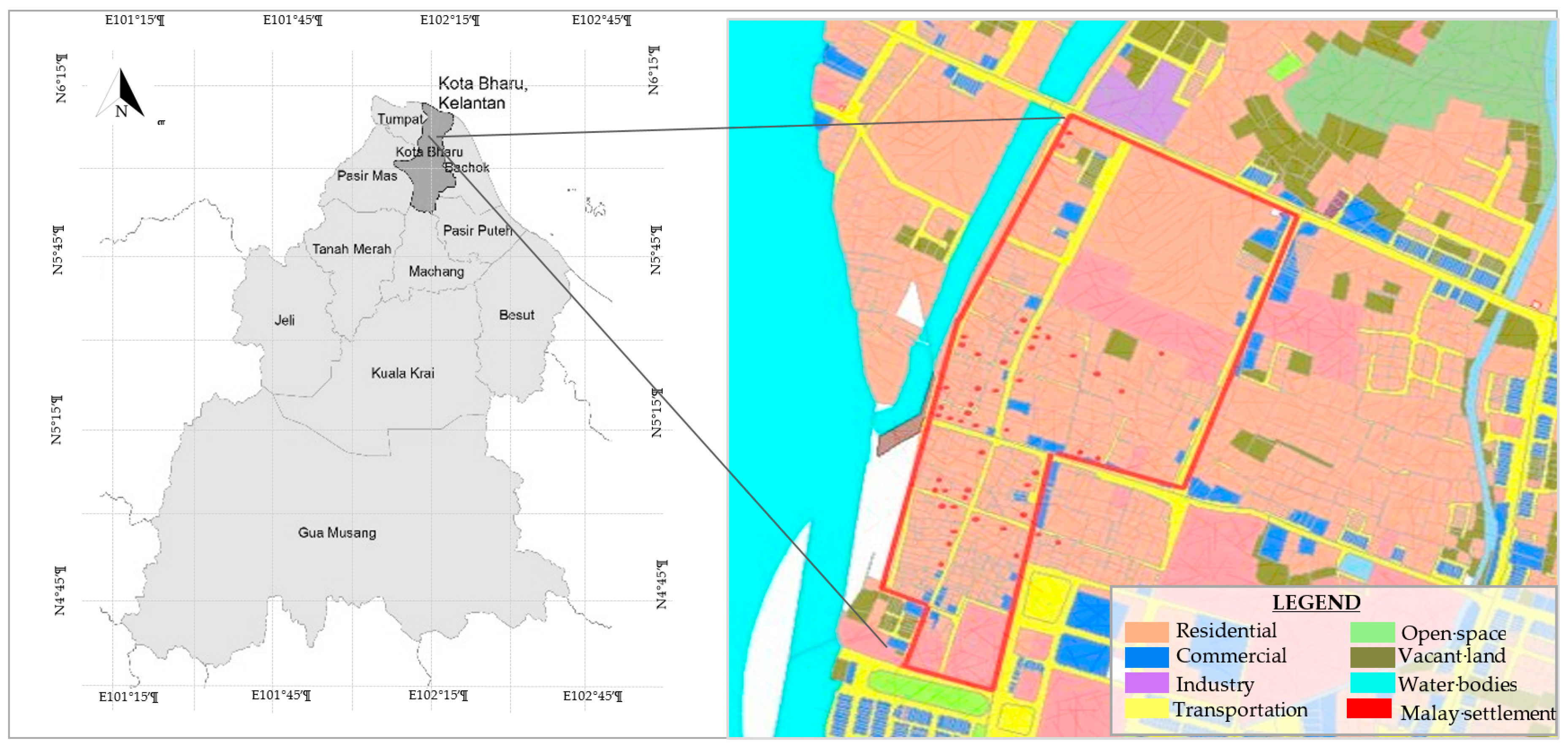

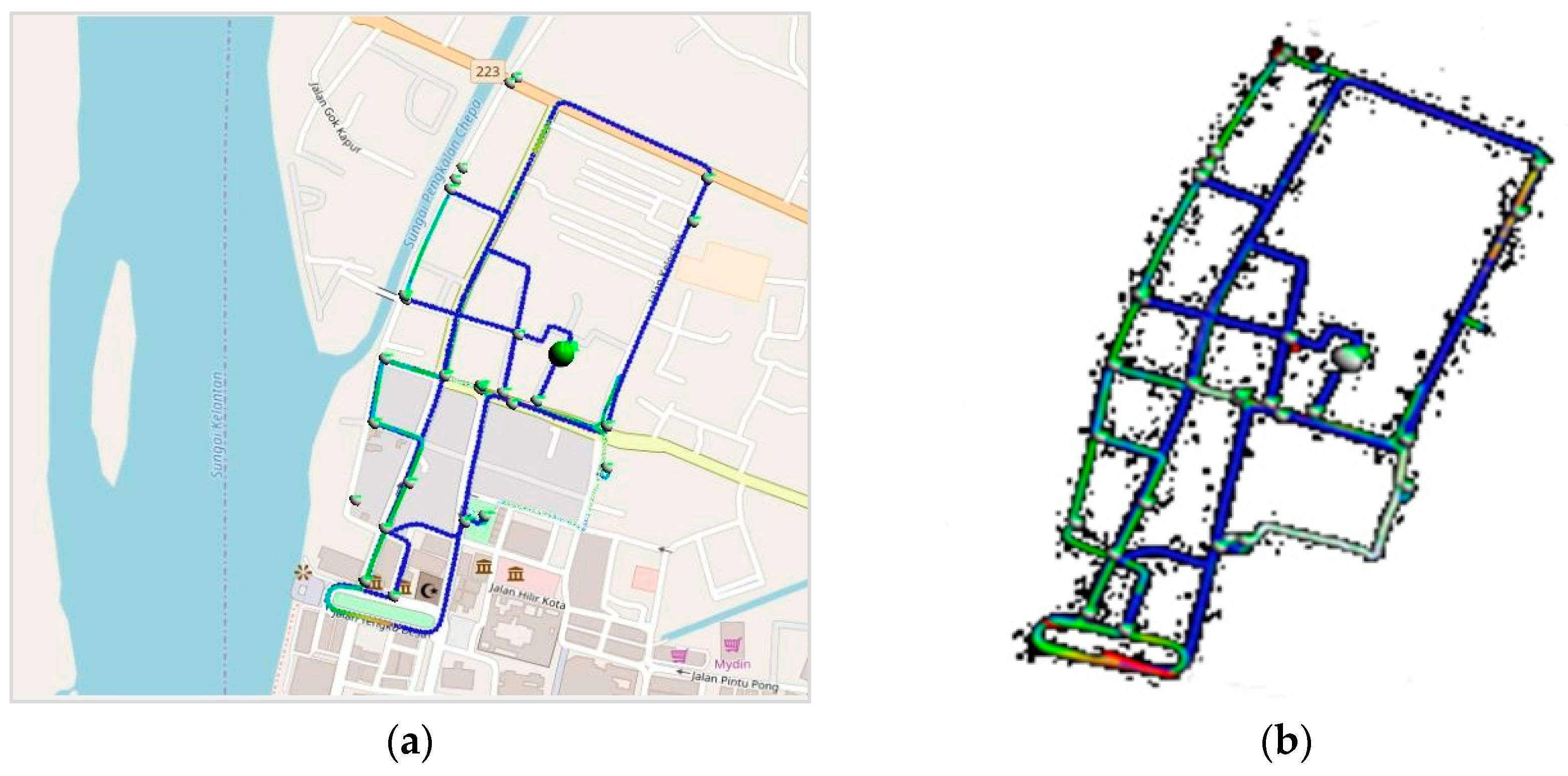
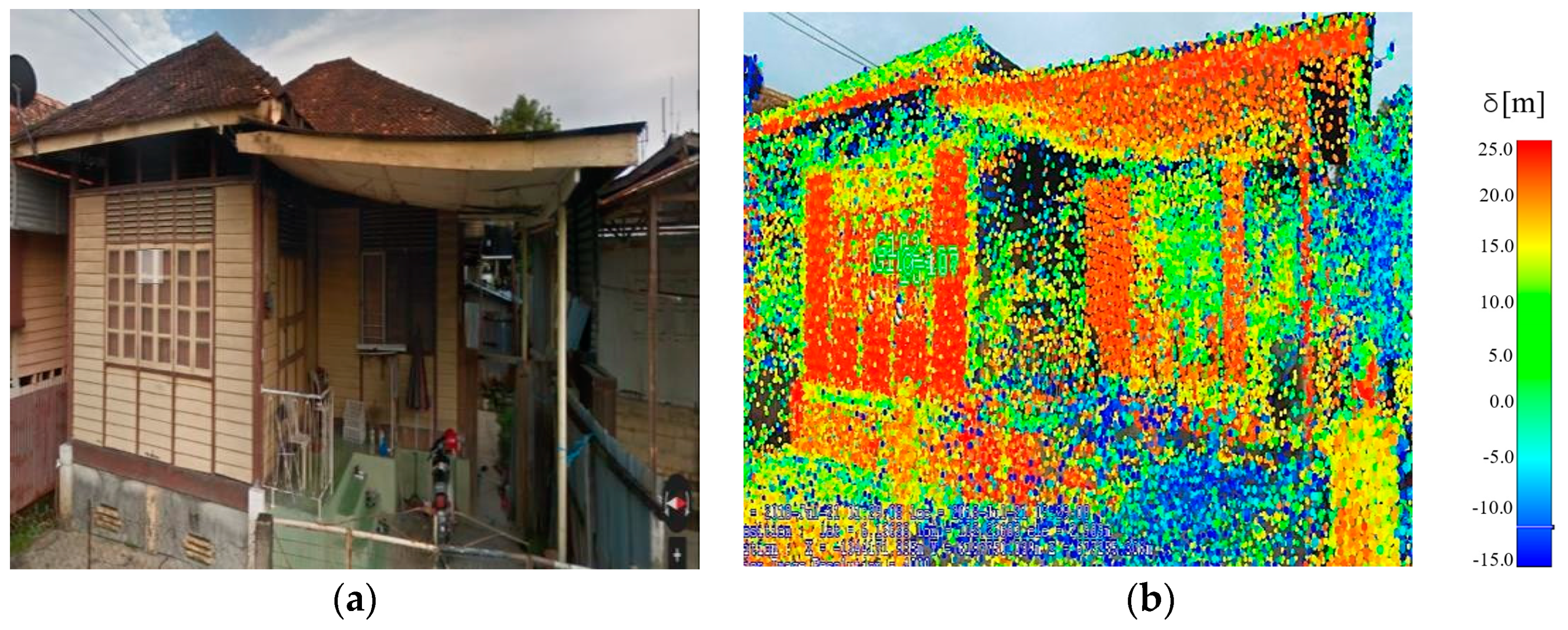
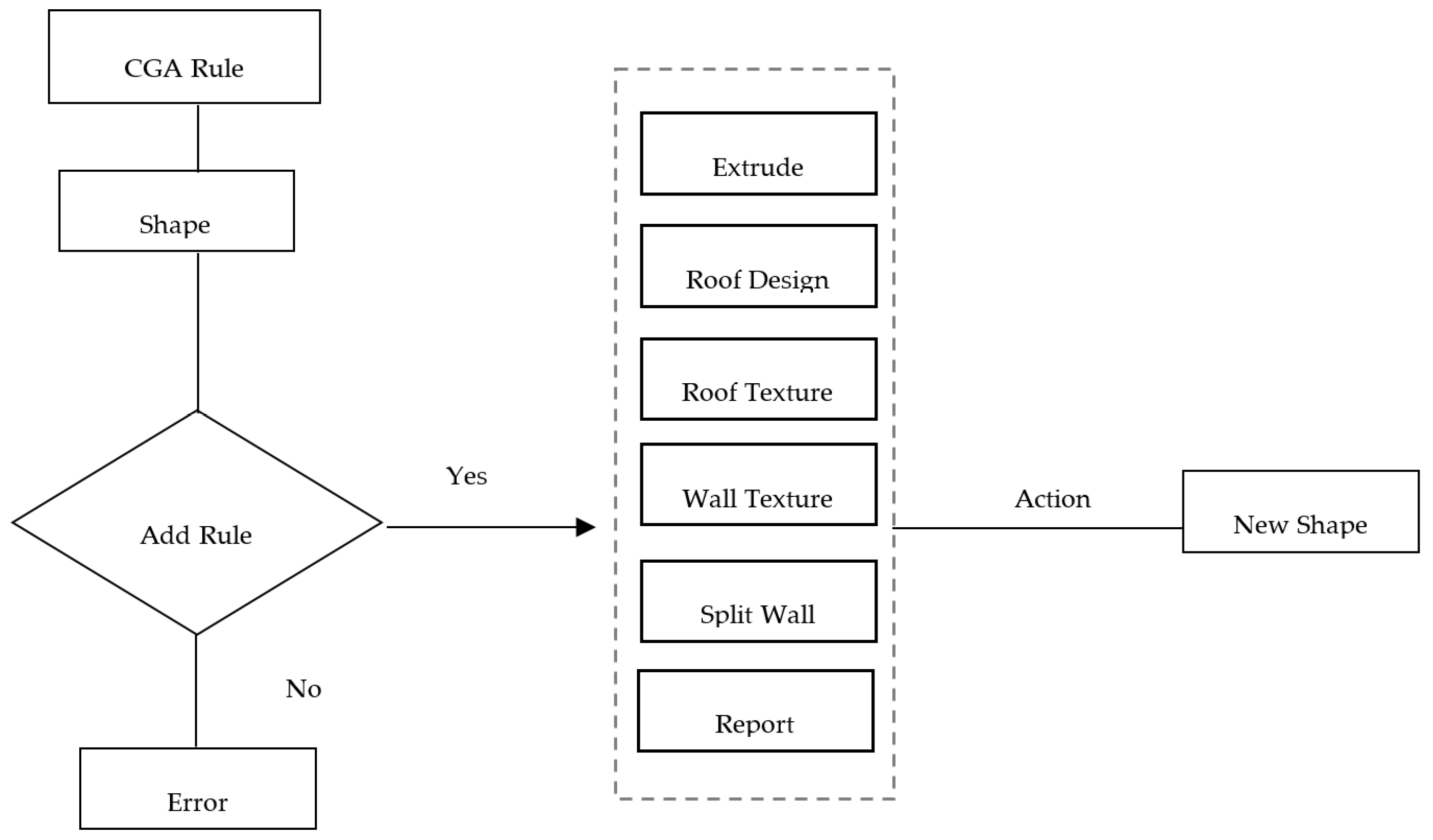
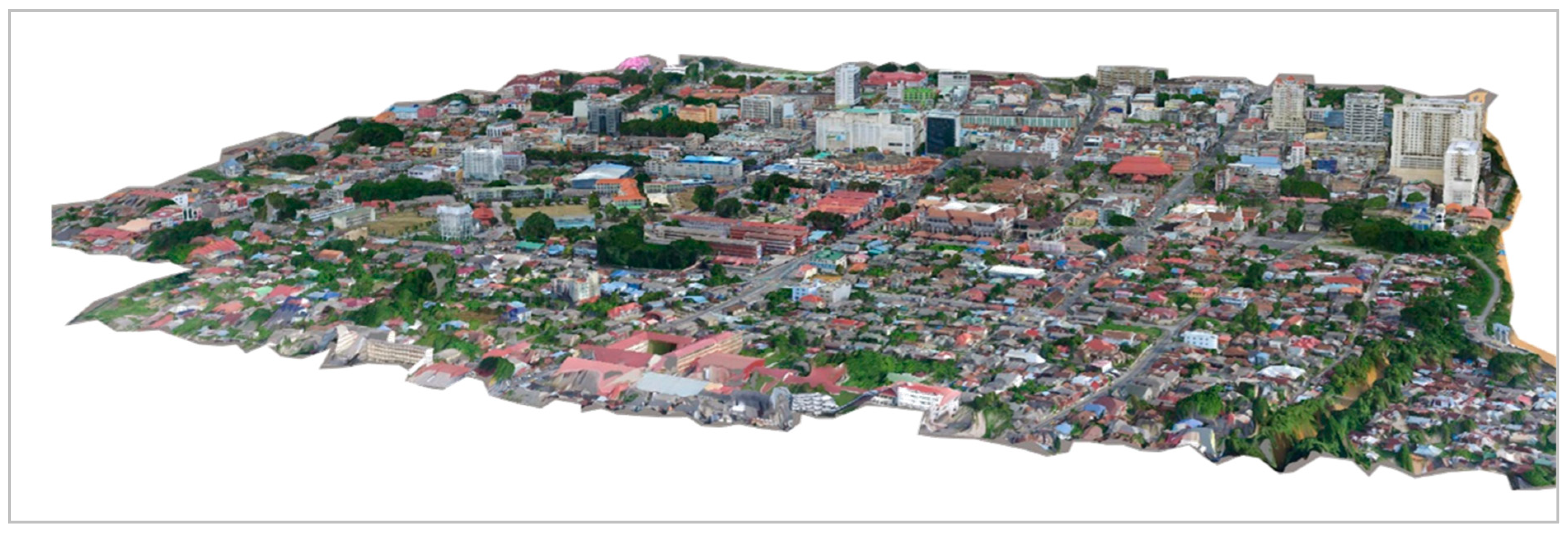
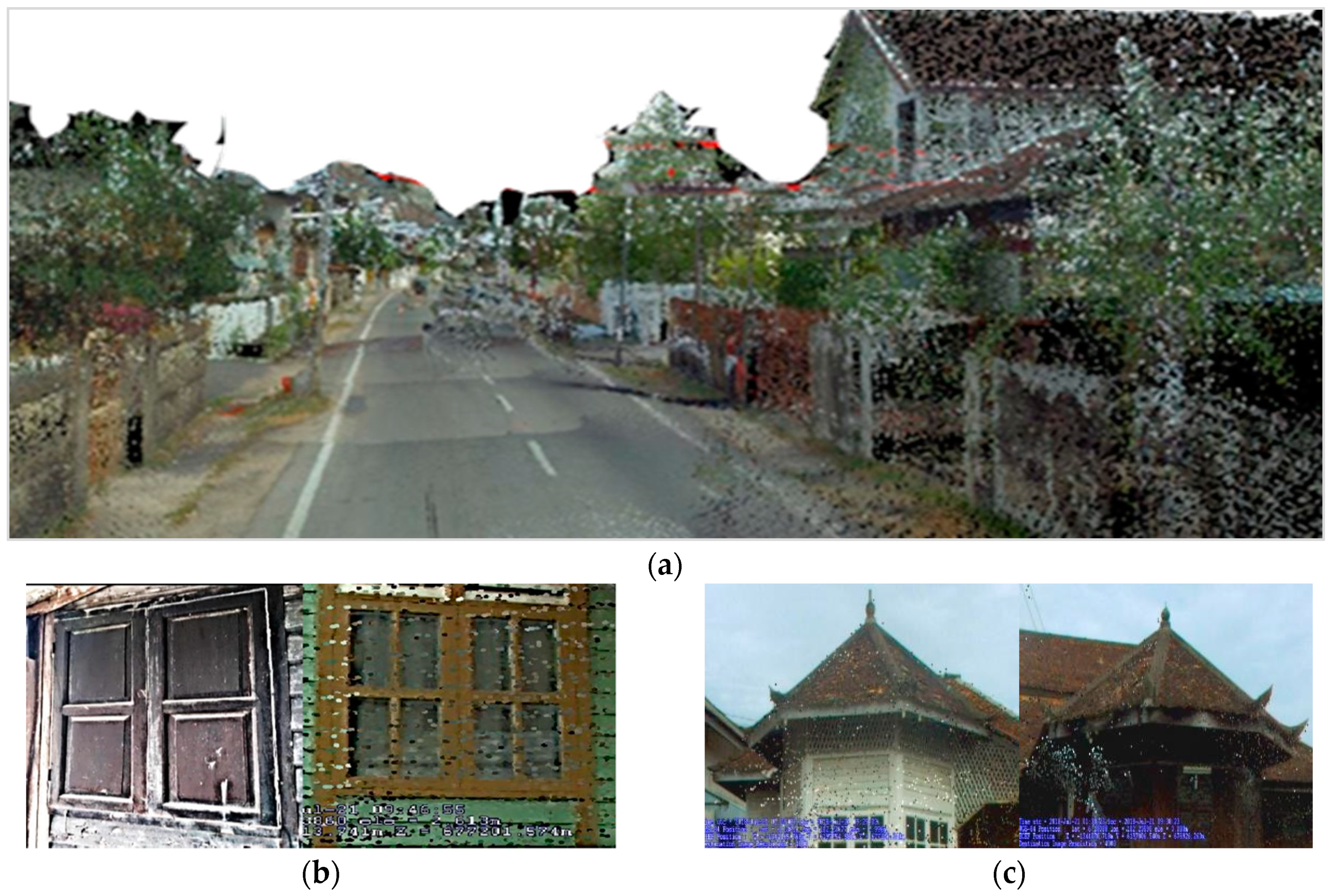
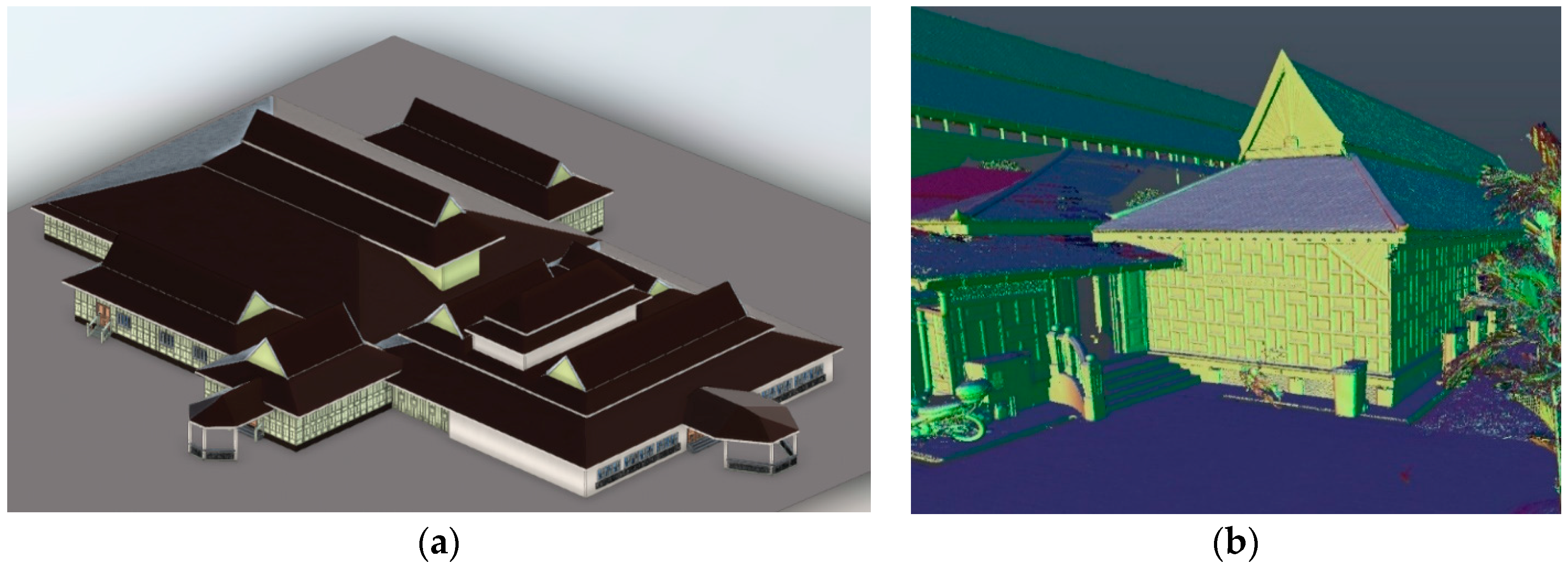
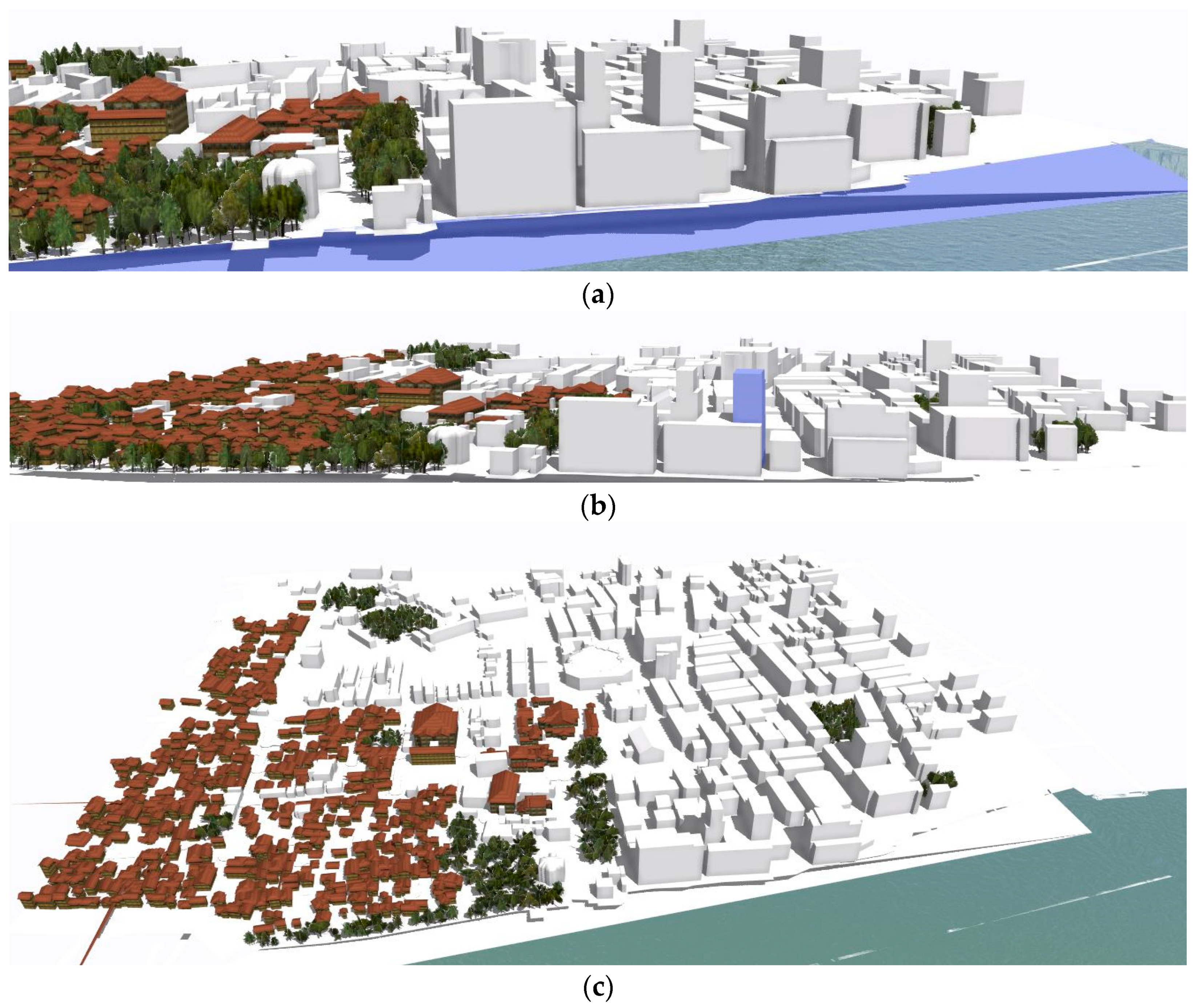
| Devices | Drone | Mobile Laser Scanner | |
|---|---|---|---|
| Types/system | DJI Phantom 3 | Topcon IP-S3 HD | |
| Multi-copter rotary wing | 3D Mobile Mapping System | ||
| Detail specification | Laser scanner point density (s–1) | 700,000 points | |
| Wheel Encoder (PPR 2) | Pulse rate 2500 PPR | ||
| Spherical camera (unit) | CCD 1 camera (6 pieces) | ||
| Mount kit (mm) | 680 (W) × 173 (D) × 1339 (H) (when slide-shortened) | ||
| Timing Box (mm) | 260 (W) × 160 (D) × 121 (H) | ||
| Flight time (min) | 25 | ||
| Year of data collection | 2018 | 2018 |
© 2020 by the authors. Licensee MDPI, Basel, Switzerland. This article is an open access article distributed under the terms and conditions of the Creative Commons Attribution (CC BY) license (http://creativecommons.org/licenses/by/4.0/).
Share and Cite
Mohd Noor, N.; Ibrahim, I.; Abdullah, A.; Abdullah, A.A.A. Information Fusion for Cultural Heritage Three-Dimensional Modeling of Malay Cities. ISPRS Int. J. Geo-Inf. 2020, 9, 177. https://doi.org/10.3390/ijgi9030177
Mohd Noor N, Ibrahim I, Abdullah A, Abdullah AAA. Information Fusion for Cultural Heritage Three-Dimensional Modeling of Malay Cities. ISPRS International Journal of Geo-Information. 2020; 9(3):177. https://doi.org/10.3390/ijgi9030177
Chicago/Turabian StyleMohd Noor, Norzailawati, Illyani Ibrahim, Alias Abdullah, and Ahmad Afiq Aiman Abdullah. 2020. "Information Fusion for Cultural Heritage Three-Dimensional Modeling of Malay Cities" ISPRS International Journal of Geo-Information 9, no. 3: 177. https://doi.org/10.3390/ijgi9030177
APA StyleMohd Noor, N., Ibrahim, I., Abdullah, A., & Abdullah, A. A. A. (2020). Information Fusion for Cultural Heritage Three-Dimensional Modeling of Malay Cities. ISPRS International Journal of Geo-Information, 9(3), 177. https://doi.org/10.3390/ijgi9030177




